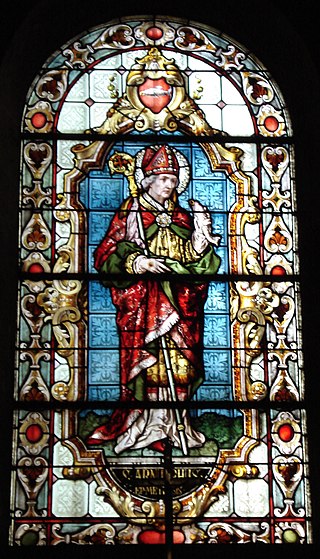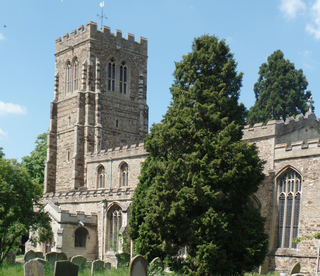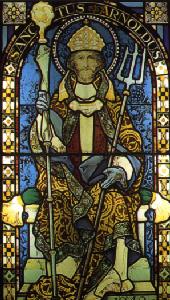Related Research Articles
Arnulf is a masculine German given name. It is composed of the Germanic elements arn "eagle" and ulf "wolf". The -ulf, -olf suffix was an extremely frequent element in Germanic onomastics and from an early time was perceived as a mere suffix forming given names. Similarly, the suffix -wald, -ald, -old, originally from wald "rule, power" underwent semantic weakening. Therefore, the name Arnulf and Arnold were often conflated in early medieval records, as is the case with bishop Arnulf of Metz, especially as the final consonant came to be dropped (Arnoul).

St Neots is a town and civil parish in the Huntingdonshire district of Cambridgeshire, England. It is 18 miles (29 km) west of Cambridge. The areas of Eynesbury, Eaton Ford and Eaton Socon form part of the town.

Arnulf of Metz was a Frankish bishop of Metz and advisor to the Merovingian court of Austrasia. He later retired to the Abbey of Remiremont. In French he is also known as Arnoul or Arnoulf. In English he is known as Arnold.

Neot was an English monk. Born in the first half of the ninth century, he lived as a monk at Glastonbury Abbey. He preferred to perform his religious devotions privately, and he later went to live an isolated life in Cornwall, near the village now called St Neot. His wisdom and religious dedication earned him admiration from the monks. He visited the Pope in Rome, who instructed him to found a monastery in Cornwall.

Eynesbury is an urban area forming part of St Neots, in the civil parish of St Neots, in the Huntingdonshire district, in the county of Cambridgeshire, England. It mainly consists of housing, although there is an area of light industry, and a large supermarket. Eynesbury is home to Ernulf Academy and a fitness centre called One Leisure. In addition there is a large area of open grassland and a caravan park. In earlier times Eynesbury was a distinct area, but nowadays it is considered to be a subdivision of St Neots.

Eaton Socon is a community in the civil parish of St Neots, in the Huntingdonshire district, in the county of Cambridgeshire, England. Eaton Socon is a component of the town of St Neots, located on its south-west margin. Eaton Socon lies on the west side of the River Great Ouse, and is bounded on the west by the A1 road and on the south by the A428 road. On the north side Duloe Brook delineates the boundary with Eaton Ford, which is also part of St Neots.

St Neots, historically in Huntingdonshire, is one of the largest towns in Cambridgeshire, England, after the cities of Cambridge and Peterborough. There is evidence of very early occupation in the area. In Roman times a fortified settlement was established, and present-day Eynesbury in particular became important, in addition to scattered settlements west of the River Great Ouse. A holy man named Saint Neot had died about the year 877 AD and his relics were held for a century in a parish in Cornwall. About 974 AD a Priory was established in the northern part of Eynesbury; the landowner took the relics of Saint Neot from the Cornish church and conveyed them to Eynesbury. This brought fame to the Eynesbury Priory, and gradually that part of the town became known as St Neots.
St Neots Priory was a Benedictine monastery beside the town of St Neots in the historic county of Huntingdonshire, now a non-metropolitan district in the English county of Cambridgeshire.

Arnold (Arnoul) of Soissons or Arnold or Arnulf of Oudenburg is a saint of the Catholic Church, the patron saint of hop-pickers, Belgian brewers.

Gertrude of Nivelles, OSB was a seventh-century abbess who, with her mother Itta, founded the Abbey of Nivelles, now in Belgium.

Drogo, also known as Dreux or Drogon, was an illegitimate son of Frankish emperor Charlemagne by the concubine Regina.
Saint Chlodulf was bishop of Metz approximately from 657 to 697.

Goeric of Metz, also known as Abbo I of Metz, Goericus of Metz, and Gury of Metz, was a bishop of Metz. He is venerated as a saint in the Eastern Orthodox and Roman Catholic Churches.

Arnoald, also called Arnoldus or Arnual, was a Bishop of Metz between 601 and 609 or 611, the successor of his uncle Agilulf. He was the son of Ansbertus, a senator, and his wife Blithilde, whose parents were Charibert I and Ingoberga.
Glodesind (572−608) was a saint, nun, abbess, and founder of a convent in Metz, France, during the time of King Childebert II (575−596) of Austrasia. She was a member of the Carolingian nobility. When she was 11 or 12 years old, she married a young nobleman, who was arrested by the French government shortly after their wedding and executed a year later. Instead of remarrying as her family wanted, she fled to Metz and took refuge at the Church of St. Stephen. Her family gave up forcing her to marry, and she became a nun and later, the abbess of a convent that was built by her parents. She was abbess for six years until her death in 608 at the age of 30. Her feast day is 8 July.
St Arnulf was Arnulf of Metz.

August 21 - Eastern Orthodox liturgical calendar - August 23

The Abbey of Saint-Arnould, St. Arnold, Saint-Arnoult or Abbey of the Holy Apostles is a Benedictine abbey residing in Metz since the 6th century.
The St Neots quads are a set of quadruplets who were born in 1935 to Doris Miles, living in Eynesbury, near St Neots, Huntingdonshire, England. A family doctor ensured that special attention was given to their care, and they were the first British quadruplets to survive more than a few days. They were regarded as a sensation by the press, and were sponsored by a baby formula manufacturer; they were frequently called on to be present at events for publicity purposes. As of 2021, they are still living and are the oldest quadruplets in the world.
Myron of Crete, called Saint Myron the Wonder Worker, was a bishop from Rhaukos, Crete who became archbishop of Crete. He is said to have been born in Aurakia, near Knossos, to have flourished during the reign of Decius, and have died in 350, at the age of 100 years. He was a farmer and "very charitable to the poor". Although he is called a holy martyr, he apparently "died a natural and quiet death".
References
- ↑ Odden, Per Einar. "Den hellige Arnulf av Eynesbury (800-t)". Den katolske kirke.
- ↑ Farmer, David (2004). "Arnulf of Eynesbury". Oxford Dictionary of Saints. OUP. ISBN 9780191579523.
- ↑ "Monks of Ramsgate|Arnulph". Book of Saints. 1921. Retrieved 30 July 2012– via CatholicSaints.Info.
 This article incorporates text from this source, which is in the public domain .
This article incorporates text from this source, which is in the public domain .